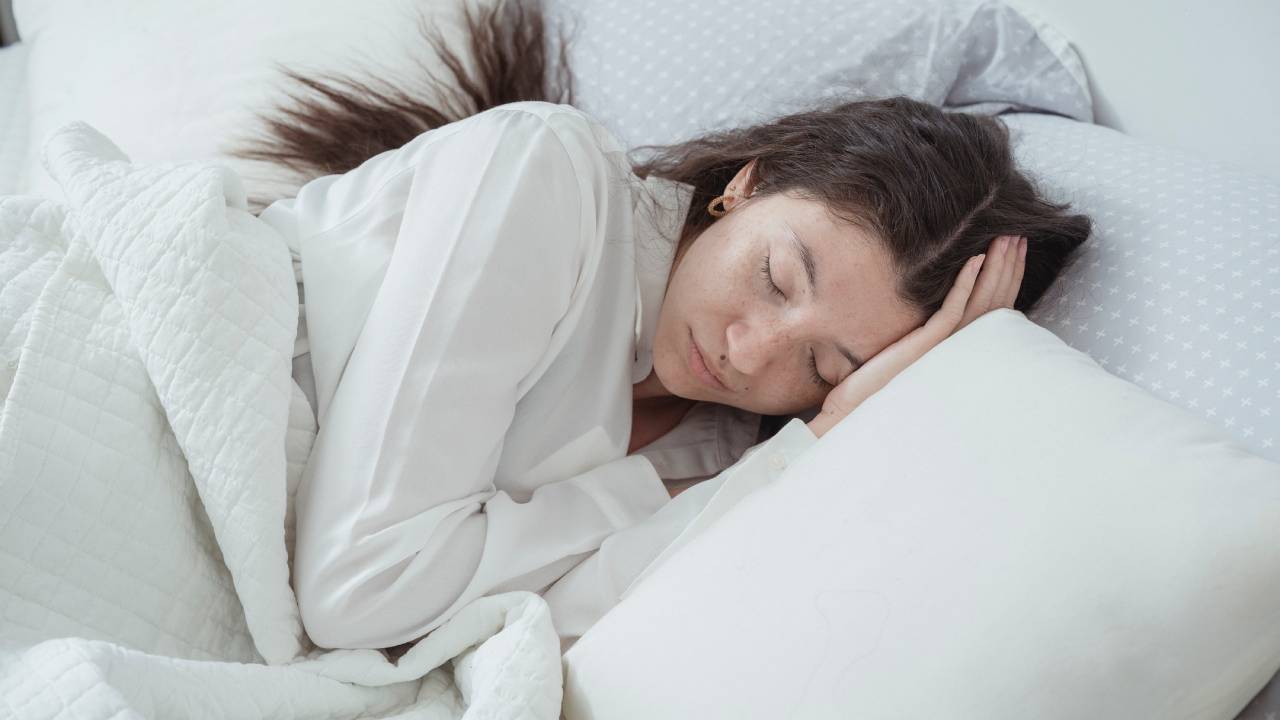I tried the 4-7-8 breathing sleep trick & it’s helped my anxiety
How the 4-7-8 breathing technique helps with sleep, stress & anxiety


We all want to sleep better at night, so much so that many people are trying strange sleep hacks in an effort to fall asleep quicker and stay asleep for longer. One sleep trick that I’ve seen popping up everywhere recently is the 4-7-8 breathing technique.
Developed by Dr Andrew Weil, the 4-7-8 breathing technique is based on an ancient yogi technique called pranayama, which is said to help yoga practitioners gain control over their breathing. Since its development, many studies have shown that the 4-7-8 technique helps encourage sleep and is often used to combat stress and anxiety.
While sleep has always come naturally to me, I do have times where I can’t fall asleep for up to an hour after I’ve turned my lights off. As someone who experiences anxiety fairly regularly, I’ve tried many breathing techniques to help ease stress, so I really wanted to give the 4-7-8 technique a try to see if it actually works. And here’s what I found…
- Get a better night’s sleep with the best mattress
- Beat stress & sleep soundly with the best essential oils
What is the 4-7-8 technique?
Popularized by integrative medicine specialist Dr Andrew Weil in 2015, 4-7-8 or the ‘relaxing breath’ is a breathing technique that acts as a natural tranquilizer for the nervous system. According to Healthline, it forces the mind and body to focus on regulating the breath, which in turns calms the nerves, clears the mind and relaxes the body.
Before I get into how to do the 4-7-8 technique, it’s important to note that to best master it, you should practice regularly. When you first start doing 4-7-8, you’ll notice subtle changes but as you repeat it, it becomes more effective. Practicing 4-7-8 at least twice a day is said to be the most beneficial for relaxation and sleep.

How to do the 4-7-8 technique
The 4-7-8 breathing technique can be practiced anywhere, as long as you have somewhere that you can sit or lie down comfortably. This is what initially drew me to this exercise as I can do it from the comfort of my home or at my desk in the office if I need to. Follow the steps below to practice 4-7-8 breathing. A full tutorial can also be found on Dr Weil’s website.
- Find a place to sit with your back straight. If you’re using 4-7-8 for sleep, feel free to lie down on your back.
- Place the tip of your tongue against the ridge of your mouth and keep it there throughout the exercise. Exhale through your mouth completely, making a whoosh sound as you do so.
- Close your mouth and inhale through your nose while you mentally count to 4.
- Hold your breath for a count of 7.
- Exhale through your mouth again while making a mental count of 8.
That’s it! The routine above is a one breath cycle, and you should repeat it three more times. On Dr Weil’s website, he comments that while the time spent on each phase doesn’t matter too much, “the ratio of 4-7-8 is important”. For example, the speed of the exercise can be quite slow or fast, meaning your mental count can be quicker if you have trouble holding your breath, but you should stick to 4-7-8 for all cycles. It might make you feel a little lightheaded at first, but once you’ve practiced a few times, you should get used to breathing deeply.
Get all the latest news, reviews, deals and buying guides on gorgeous tech, home and active products from the T3 experts
Does the 4-7-8 technique help with sleep & anxiety?
I’ve tried the 4-7-8 technique intermittently but once I saw it blowing up, I thought I’d make it a regular habit. For several nights, I got into bed, lay on my back with my palms on my chest and focused on the 4-7-8 cycle. Clearing my mind and concentrating solely on my breathing was a huge help. As someone who worries about the tiniest things, I mainly stay awake longer before falling asleep because my brain won’t shut off, so having something to focus on massively slowed this down.
After trying the 4-7-8 trick a few times, I found that my whole body felt more relaxed and ready to go to sleep after I’d completed the cycles. My overall mood felt better too, and I felt less anxious which helped me sleep better and not wake up through the night. If I did wake up during the night, I simply did 4-7-8 again and found myself relaxing into sleep once more. Overall, after trying the 4-7-8 breathing sleep trick, I can confidently say it’s my go-to if I’m struggling to get to sleep or if I’m feeling anxious.
Researchers have found that alongside better sleep and less stress, the 4-7-8 technique also has many health benefits. In a CNN article about the 4-7-8 technique, it stated that researchers saw an increase in theta and delta brain waves from 4-7-8 breathing,which indicates that someone is in a parasympathetic state, aka the ‘rest and digest’ state. As suggested in studies, counting is what is said to help people relax most easily, as they’re focused on something rather than letting the mind wander. Breathing deeply like this also signals to the body that it's time to relax due to the amount of oxygen being exhaled, according to Prevention.
So, if you’re having trouble sleeping, practicing the 4-7-8 technique could help you relax and fall asleep quicker. For other sleep hacks, try this 30-second sleep psychologist hack or fall asleep in 2 minutes with a sleep technique used by the US army.

Beth is Home Editor for T3, looking after style, living and wellness. From the comfiest mattresses to strange things you can cook in an air fryer, Beth covers sleep, smart home, coffee machines, watches, grooming tools, fragrances, gardening and more.
In her spare time, Beth enjoys running, reading, baking and attempting craft projects that will probably end in disaster!